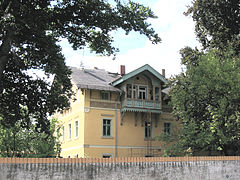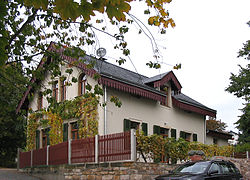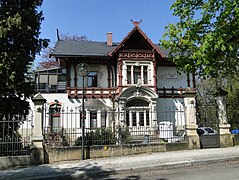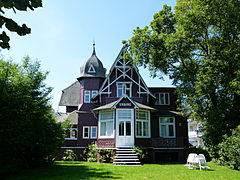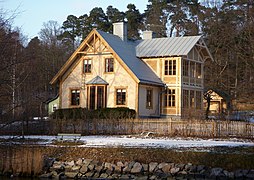Swiss style
The Swiss style , also Swiss house style , Swiss wood style or chalet style , is an architectural direction of historicism and describes buildings in the - alleged - style of alpine farmhouses. In Austria the term “ Heimatstil ” is common, but it is used in a more comprehensive sense for all historicist architecture based on traditional building forms.
description
The Swiss style is characterized in particular by gently sloping and protruding roofs as well as by board carvings on roofs, balconies and exits in the form of board carvings. The windows look on ornate wooden consoles . The "Swiss gable", a floating gable in front of the gable, is also a typical design element.
Historical classification
This architectural style was popular from the 19th century to the Belle Epoque at the beginning of the 20th century in Germany, Austria-Hungary and Scandinavia. A real enthusiasm for Switzerland with the romantic ideal of closeness to nature had gripped all of Europe in the late 18th century. The simple life of the mountain farmer was mythologized - by thinkers such as Jean-Jacques Rousseau - and nature equated with truth. The Swiss style should represent a counter-image to the emerging industrialization .
The first Swiss houses were built as a typical staffage element in the landscape gardens and mostly served as a residence for gardeners or park rangers. Later they appeared in city locations such as Dresden . At the beginning of the 19th century, the style found its way into Switzerland itself, where it was used for villas and later preferred for train stations and hotels.
Well-known architects such as Karl Friedrich Schinkel built in the Swiss style. In 1811 he had undertaken architectural studies in the Alps on a trip and in 1829 designed a Swiss house with staff apartments for the Pfaueninsel .
The Swiss style was spread through master works. The fashion of the Swiss house ebbed at the beginning of the 20th century.
Other names for the Swiss style
The Swiss style is also known under the terms wood style, fretwork architecture, fretwork architecture, Chalet Suisse or Swiss Cottage. The term chalet also stands for an architectural style that is widespread far beyond Switzerland, but requires a facade made exclusively of wood.
Examples
Today there are many Swiss-style villas in the Dresden area , in resorts in the German low mountain range such as in the Harz Mountains , in northern Bohemia and in major southern German cities. There are also examples of villas in the Swiss chalet style in the seaside resorts such as Binz and Heringsdorf , which are characterized by spa architecture - these buildings often come from the production of the Wolgaster Holzbau corporation .
- In the Klein-Glienicke district of Potsdam there is a whole colony of Swiss houses that Carl von Prussia commissioned from Ferdinand von Arnim from 1863–1887 . Four of the former ten buildings are still standing in 2017.
- In the Rödelheim district of Frankfurt , Georg Brentano had the Petrihaus , a half-timbered house from the 18th century, rebuilt from 1819 and furnished with elements typical of the Swiss house and late classicist.
- In Tettnang there is a building constructed in wood for the senior veterinarian Locher, with imposing loggias and balconies on top of each other.
- The royal house on Schachen , south of Garmisch-Partenkirchen, built for the Bavarian King Ludwig II .
Picture galleries
- Germany
Swiss-style house ( gardener's house in the Goldschmidtvilla in Radebeul, Saxony)
Garrison rifle house from 1893, Stuttgart
Villa in Munich by Max Littmann
Swiss cottage in Anholter Switzerland , Isselburg -Vehlingen
Gasthaus am Lichtenhain waterfall (built 1852/1853) in the Elbe Sandstone Mountains
- Other countries
Johansdal from 1881, Djurgården , Sweden
Swiss-style villa by Heinrich Juergensen in Oslo , Norway in 1897
Kurhotel Rosenlaui in Switzerland
Well-known architects
literature
- Hartmut Gräfe: About Swiss houses in Saxon Switzerland. In: Landesverein Sächsischer Heimatschutz , Saxon State Center for Political Education (Hrsg.): Rural area in Saxony. Dresden 2017, pp. 210–212.
- Karin von Wietersheim Eskioglou: The Swiss style and the development of modern Swiss wooden house construction. Zurich 2004 ( PDF; 37 MB ).
Web links
- Schweizerhaus on denkmalschutz.de
Individual evidence
- ↑ Volker Helas (arrangement): City of Radebeul . Ed .: State Office for Monument Preservation Saxony, Large District Town Radebeul (= Monument Topography Federal Republic of Germany . Monuments in Saxony ). SAX-Verlag, Beucha 2007, ISBN 978-3-86729-004-3 , p. 342 .
- ↑ Beatrice Härig: What are ... Swiss houses? In: German Foundation for Monument Protection (Hrsg.): Monuments . 27. Vol. 5 / October 2017. German Foundation for Monument Protection, Bonn 2017, p. 58-59 .
- ↑ See Hans-Ulrich Bauer: Holzhäuser from Wolgast. Icons of resort architecture. Heringsdorf 2010 and 2011.

